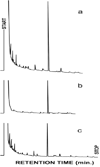Presence of wax esters and squalene in human saliva
- PMID: 21247555
- PMCID: PMC3095707
- DOI: 10.1016/j.archoralbio.2010.12.002
Presence of wax esters and squalene in human saliva
Abstract
Objective: The purpose of this study was to determine the presence and relative composition of neutral lipids in human saliva.
Design: Whole unstimulated saliva was collected from 12 subjects ranging from 21 to 29 years old. Samples were lyophilized, and lipids were extracted using chloroform-methanol. Lipids were analysed by thin-layer chromatography.
Results: Human saliva contains cholesterol, fatty acids, triglycerides, wax esters, cholesterol esters and squalene. The mean total neutral lipid content was 12.1±6.3 μg/ml.
Conclusions: These lipids in human saliva closely resemble the lipids found on the skin surface. These salivary lipids are most likely produced by the sebaceous follicles in the oral mucosa and sebaceous glands associated with major salivary glands.
Copyright © 2010 Elsevier Ltd. All rights reserved.
Figures


References
-
- Slomiany BL, Murty VL, Slomiany A. Salivary lipids in health and disease. Progress in Lipid Research. 1985;24(4):311–324. - PubMed
-
- Larsson B, Olivecrona G, Ericson T. Lipids in human saliva. Archives of oral Biology. 1996;41(1):105–110. - PubMed
-
- Meleti M, Vescovi P, Mooi WJ, van der Waal I. Pigmented lesions of the oral mucosa and perioral tissues: a flow-chart for the diagnosis and some recommendations for the management. Oral Surgery, Oral Medicine, Oral Pathology, Oral Radiology and Endodontics. 2008;105(5):606–616. - PubMed
-
- Gulec AT, Haberal M. Lip and oral mucosal lesions in 100 renal transplant recipients. Journal of the American Acadamy of Dermatology. 2010;62(1):96–101. - PubMed
-
- Gorsky M, Buchner A, Fundoianu-Dayan D, Cohen C. Fordyce’s granules in the oral mucosa of adult Israeli Jews. Community Dentistry and Oral Epidemiology. 1986;14(4):231–232. - PubMed
Publication types
MeSH terms
Substances
Grants and funding
LinkOut - more resources
Full Text Sources

